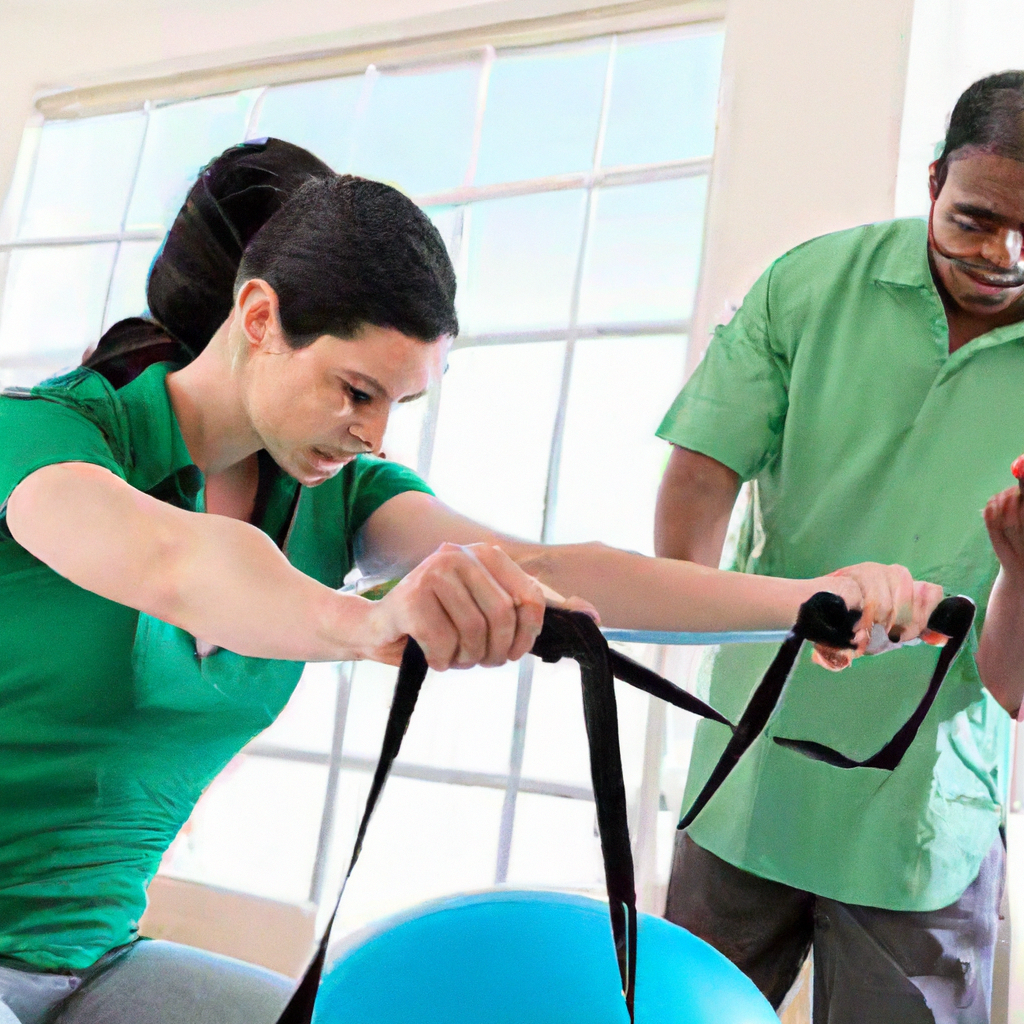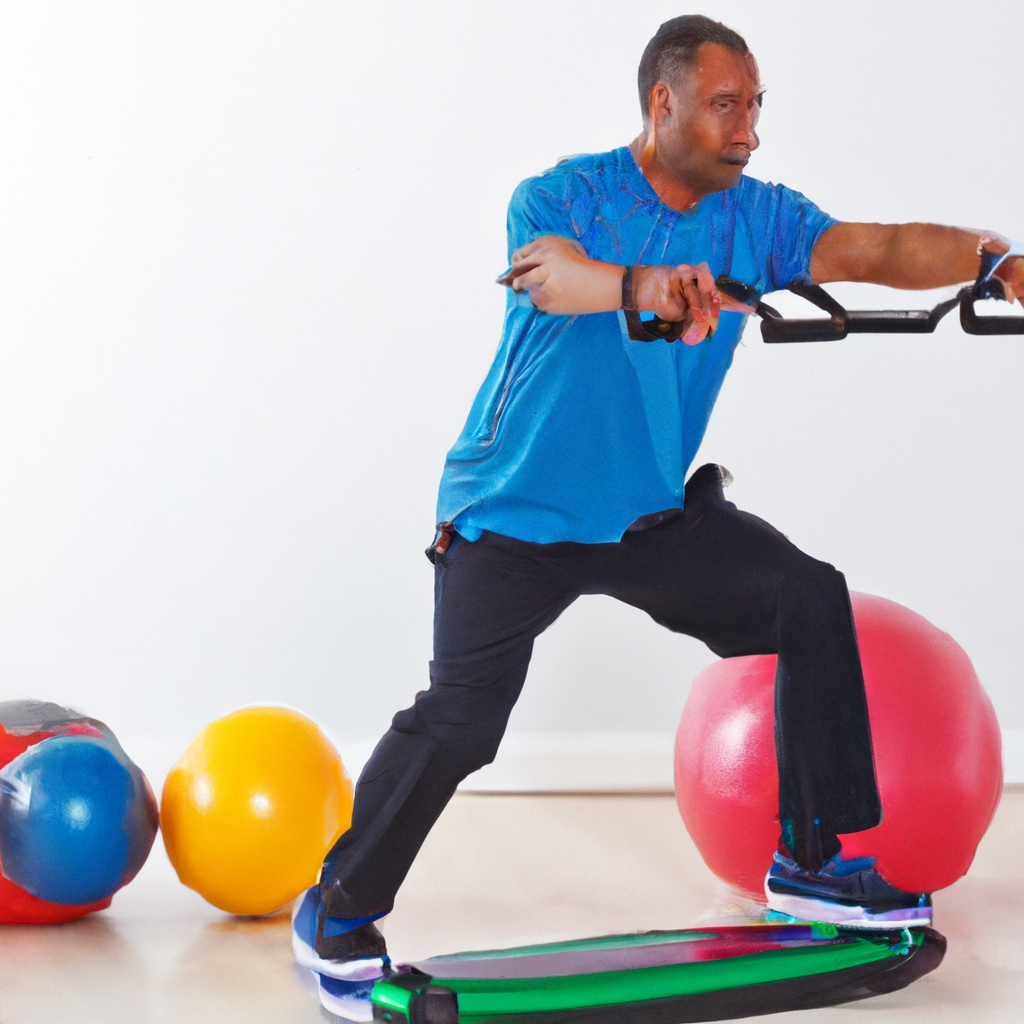If you find yourself on the road to recovery after sustaining an injury, you may be wondering if fitness equipment can play a role in aiding your rehabilitation process. The answer, my friend, is a resounding yes! Fitness equipment, when used correctly and in conjunction with appropriate medical guidance, can be a valuable tool to help you regain strength, increase flexibility, and rebuild muscle after an injury. In this article, we will explore the different types of fitness equipment that can be beneficial for injury rehabilitation and how they can contribute to your overall recovery journey. So let’s strap on our metaphorical sneakers and embark on a journey to discover the potential of fitness equipment in your rehabilitation process!
Benefits of Fitness Equipment for Injury Rehabilitation
Enhances Range of Motion
Using fitness equipment in injury rehabilitation can greatly enhance your range of motion. Many injuries cause stiffness and limited movement in certain areas of the body. By incorporating exercises with equipment such as resistance bands, exercise balls, and Pilates equipment, you can effectively target and improve your range of motion, allowing your body to move more freely and comfortably.
Strengthens Muscles
A key benefit of using fitness equipment in injury rehabilitation is the ability to strengthen weakened muscles. After an injury, muscles often become weak and lose their normal function. Fitness equipment such as dumbbells, rowing machines, and medicine balls provide resistance and targeted exercises that can help rebuild strength and muscle tone. Strengthening your muscles not only aids in injury recovery but also prevents future injuries by providing support and stability.
Improves Cardiovascular Health
Injury rehabilitation doesn’t just focus on the injured area; it should also address your overall fitness and cardiovascular health. Fitness equipment like elliptical machines, stationary bikes, and treadmills offer low-impact cardiovascular exercises that can improve your heart health and circulation. Engaging in regular cardiovascular exercise not only helps speed up your recovery but also improves your overall fitness level and endurance.
Enhances Flexibility
Incorporating fitness equipment into your injury rehabilitation program can also enhance your flexibility. Whether it’s using resistance bands for stretching exercises or utilizing Pilates equipment for dynamic movements, these exercises can help improve your flexibility and joint mobility. Increasing your flexibility not only aids in injury prevention but also allows for better performance in daily activities and sports.
Facilitates Balance and Stability
Maintaining balance and stability is crucial during injury rehabilitation to prevent further injuries and promote proper healing. Fitness equipment like balance boards and exercise balls are excellent tools for improving your balance and stability. These equipment challenge your body’s ability to maintain equilibrium, thereby enhancing proprioception and reducing the risk of falls or re-injury.
Promotes Joint Stability
After an injury, it’s essential to restore stability to the affected joints. Fitness equipment provides targeted exercises that promote joint stability and help prevent instability and pain. Resistance bands, exercise balls, and Pilates equipment can all be used to improve joint stability by targeting specific muscle groups that support the joints. Through regular exercise with fitness equipment, you can regain confidence in your joints’ stability and reduce the risk of future injuries.
Enhances Proprioception
Proprioception, or your body’s awareness of its position in space, is often impaired after an injury. Fitness equipment plays a vital role in enhancing proprioception during rehabilitation. By performing exercises on unstable surfaces such as balance boards or using resistance bands to challenge your body’s alignment, you can improve your proprioceptive abilities. Enhancing proprioception helps prevent future injuries and allows for better coordination and control of movement.
Promotes Proper Technique and Form
Using fitness equipment during injury rehabilitation promotes proper technique and form. It provides a structured and controlled environment where you can focus on performing exercises correctly. Fitness equipment often comes with instructional guides or can be used under the guidance of a healthcare professional or certified trainer. Proper technique and form not only maximize the effectiveness of each exercise but also minimize the risk of further injury.
Facilitates Progressive Rehabilitation
Fitness equipment allows for progressive rehabilitation by providing various levels of resistance and intensity. Many fitness equipment, such as resistance bands, dumbbells, and exercise machines, have adjustable resistance settings that can be gradually increased as your strength and fitness improve. This gradual progression is essential in ensuring safe and effective rehabilitation, allowing you to gradually challenge your body and push your limits without risking re-injury.
Promotes Psychological Well-being
The benefits of fitness equipment in injury rehabilitation are not solely physical; they also extend to your mental well-being. Engaging in regular exercise with fitness equipment releases endorphins, often referred to as “feel-good” hormones, which can help reduce stress, anxiety, and depression. It provides a sense of accomplishment and empowerment, boosting your confidence and motivation throughout the rehabilitation process.
Types of Fitness Equipment for Injury Rehabilitation
Resistance Bands
Resistance bands are versatile and inexpensive tools that can help with injury rehabilitation. They provide adjustable resistance, making them suitable for individuals of all fitness levels. Resistance band exercises can target specific muscle groups and aid in improving range of motion, strength, and flexibility.
Exercise Balls
Exercise balls are large, inflatable balls that can be utilized in various exercises to improve core stability, balance, and strength. They can be used for seated exercises or as a support surface for exercises targeting different muscle groups, making them particularly beneficial for individuals with back or spinal injuries.
Balance Boards
Balance boards are useful for working on ankle stability and improving balance. These boards have a fulcrum or pivot point that challenges your body to maintain balance and engage core muscles for stabilization. By regularly using a balance board, you can enhance proprioception and prevent future ankle injuries.
Elliptical Machines
Elliptical machines provide low-impact cardiovascular exercise that minimizes stress on the joints while still offering an effective workout. They are particularly beneficial for lower body rehabilitation as they engage multiple muscle groups and promote cardiovascular health without putting excessive strain on the injured area.
Stationary Bikes
Stationary bikes are another excellent option for low-impact cardiovascular exercise. They are especially beneficial for individuals with knee or hip injuries as they provide a non-weight bearing exercise that allows for a controlled range of motion. Stationary bikes can be adjusted to fit various fitness levels and rehabilitation goals.
Treadmills
Treadmills offer a controlled and cushioned surface for walking, jogging, or running exercises. They are commonly used for gait training and retraining proper walking mechanics after lower body injuries. Treadmills also provide cardiovascular benefits and can be adjusted to accommodate different levels of fitness and rehabilitation progress.
Rowing Machines
Rowing machines provide a full-body workout that engages both the upper and lower body muscles. These machines offer low-impact cardiovascular exercise while strengthening muscles and improving joint mobility. Rowing machines are particularly useful for upper body rehabilitation or individuals looking for a comprehensive workout.
Medicine Balls
Medicine balls are weighted balls that can be used to add resistance and challenge to exercises. They can be thrown, caught, or lifted, targeting various muscle groups and promoting power, coordination, and core strength. Medicine ball exercises are effective in rehabilitation programs for individuals recovering from upper body or core injuries.
Dumbbells
Dumbbells are versatile and widely used fitness equipment for strength training. They come in various weights, allowing you to gradually increase the resistance as your strength improves. Dumbbell exercises target specific muscle groups and promote overall strength and stability during injury rehabilitation.
Pilates Equipment
Pilates equipment, such as reformers, can be highly beneficial for injury rehabilitation. These machines utilize springs and resistance mechanisms to target specific muscle groups and improve strength, flexibility, balance, and posture. Pilates exercises on equipment provide controlled movements and promote proper body alignment throughout the rehabilitation process.

Considerations when Using Fitness Equipment for Injury Rehabilitation
Consultation with a Healthcare Professional
Before incorporating fitness equipment into your injury rehabilitation program, it is important to consult with a healthcare professional. They can provide guidance on which equipment is suitable for your specific injury, help design a personalized rehabilitation plan, and ensure proper technique and form to prevent further injury.
Proper Technique and Form
Using fitness equipment correctly is crucial for effective and safe injury rehabilitation. Improper technique and form can lead to further injuries or hinder progress. It is important to learn and practice proper technique under the guidance of a healthcare professional or certified trainer to maximize the benefits of using fitness equipment.
Gradual Progression
In injury rehabilitation, it is important to gradually increase the intensity and difficulty of exercises. Gradual progression allows your body to adapt to the demands placed on it without risking re-injury. Start with lower resistance or weight and gradually increase as you build strength and confidence. Listen to your body and do not push beyond your limits too quickly.
Avoidance of Overexertion
While it is essential to challenge yourself during injury rehabilitation, it is equally important to avoid overexertion. Pushing too hard or performing exercises beyond your current capabilities can lead to increased pain, discomfort, and setbacks in your recovery. Pay attention to your body’s signals and work within your limits.
Personal Safety Precautions
When using fitness equipment, it is crucial to prioritize personal safety. This includes using proper protective gear, such as supportive shoes or joint braces, to minimize the risk of injury. Additionally, ensuring a safe exercise environment by clearing any obstacles or hazards is important to prevent accidents.
Monitoring and Adjustments
Rehabilitation progress varies for each individual, and it is important to continually monitor and make adjustments to your fitness equipment usage accordingly. Regularly assess your strength, range of motion, and overall comfort level to determine if any modifications or changes are needed in your rehabilitation program. Seeking professional guidance can be helpful in assessing and adjusting your plan.
Proper Maintenance and Cleaning
To ensure the longevity and effectiveness of fitness equipment, it is important to follow proper maintenance and cleaning guidelines. Regularly inspect the equipment for any signs of wear or damage and address them promptly. Clean the equipment after each use to prevent the buildup of bacteria or germs that could potentially cause infections.
Cost Considerations
Fitness equipment can vary in cost, and it is important to consider your budget when selecting equipment for injury rehabilitation. There are a wide range of options available, from basic resistance bands to more advanced machines, and choosing the equipment that aligns with your rehabilitation goals and budget is crucial.
Availability and Accessibility
Consider the availability and accessibility of the fitness equipment you plan to use for injury rehabilitation. Access to certain equipment may be limited based on your location or facility resources. It is important to ensure that you have access to the necessary equipment or alternatives that can effectively support your rehabilitation goals.
Compatibility with Rehabilitation Goals
When choosing fitness equipment for injury rehabilitation, it is important to select equipment that aligns with your specific rehabilitation goals. Different injuries may require emphasis on different areas of the body or specific types of exercises. Consult with a healthcare professional to determine which equipment provides the most benefit for your specific injury and recovery process.
Examples of Fitness Equipment used in Injury Rehabilitation
Resistance Band Exercises
Resistance bands are commonly used for a variety of exercises in injury rehabilitation. Examples include shoulder external rotation exercises to strengthen rotator cuff muscles, leg abduction exercises to target hip stability, and bicep curls to build upper body strength.
Ball Exercises for Core Stability
Exercise balls are excellent tools for targeting core stability. Examples of exercises include seated torso rotations to engage the abdominal muscles, plank exercises to strengthen the core and back muscles, and back extensions to promote spinal stability.
Balance Board Exercises for Ankle Stability
Balance boards are particularly useful for ankle rehabilitation. Exercises may include standing exercises on the board to improve ankle strength and stability, single-leg squats to challenge balance and coordination, and calf raises to enhance lower leg strength.
Low Impact Cardiovascular Exercises
Low impact cardiovascular exercises, such as using the elliptical machine or stationary bike, are commonly used in injury rehabilitation. These exercises provide a cardiovascular workout without placing excessive stress on the joints, making them suitable for individuals recovering from lower body injuries or joint conditions.
Functional Training with Dumbbells
Dumbbells can be incorporated into functional training exercises to improve overall strength and mobility. Examples include squats with dumbbells to target lower body muscles, overhead presses to strengthen shoulder muscles, and lunges with dumbbell curls to work multiple muscle groups simultaneously.
Reformer Pilates for Rehabilitation
Reformer Pilates machines can be used in injury rehabilitation to promote strength, flexibility, and balance. Exercises on the reformer include leg presses to engage leg muscles, chest presses to target the upper body, and torso rotations to enhance core stability.
Exercise Bike for Knee Rehabilitation
Exercise bikes are often used in knee rehabilitation as they provide a low-impact workout that promotes knee flexibility and strength. Exercises may include cycling with adjustable resistance, isolated knee extensions, and seated leg presses to target the quadriceps and hamstrings.
Treadmill Workouts for Gait Training
Treadmill workouts are commonly utilized in gait training after lower body injuries or surgeries. Exercises may include walking or jogging on the treadmill with gradual increments in speed and incline to gradually restore normal walking mechanics and improve cardiovascular endurance.
Rowing Machine Exercises for Upper Body Rehabilitation
Rowing machines offer a full-body workout that can be beneficial for upper body rehabilitation. Exercises may include seated rows to target the upper back muscles, bicep curls to strengthen the arms, and tricep extensions to tone the back of the arms.
Medicine Ball Exercises for Power and Coordination
Medicine ball exercises are effective for improving power, coordination, and overall strength. Examples include medicine ball slams to engage the core and upper body muscles, medicine ball twists to target the obliques, and medicine ball push-ups to challenge the upper body and core stability.

Tips for Effective Fitness Equipment Use during Injury Rehabilitation
Proper Warm-up and Cool-down
Before and after each workout session, it is important to properly warm up and cool down. Warm-up exercises can include light stretching, mobility exercises, or even gentle cardiovascular exercise to prepare your body for the upcoming workout. Cooling down helps transition your body back to a resting state and promotes proper recovery.
Customized Rehabilitation Programs
Every injury is unique, and it is essential to have a customized rehabilitation program tailored to your specific needs. Working with a healthcare professional or certified trainer who specializes in injury rehabilitation can help ensure that your program is designed to address your specific injury, goals, and progress.
Consistency and Regularity
Consistency and regularity are key to successful injury rehabilitation. Establish a consistent workout routine that includes regular sessions with fitness equipment. This consistent schedule not only promotes better physical outcomes but also helps with motivation and focus during your rehabilitation journey.
Gradual Increment in Intensity
Gradually increase the intensity of your exercises as you progress through your rehabilitation program. Start with lighter resistance or lower weights and gradually increase as your strength and endurance improve. This gradual increment in intensity allows your body to adjust and adapt without overexertion.
Monitoring Progress and Adjustments
Regularly monitor your progress and make appropriate adjustments to your rehabilitation program. Keep track of your strength gains, range of motion improvements, and overall comfort levels. Consider seeking professional guidance periodically to evaluate your progress and make any necessary modifications to your program.
Listening to the Body
Pay attention to your body during your injury rehabilitation journey. Listen to any discomfort or pain signals and adjust your exercises or intensity accordingly. Pushing through excessive pain or discomfort can worsen an injury or hinder your progress. It is important to strike a balance between challenging yourself and respecting your body’s limitations.
Balancing with Manual Therapies
Incorporating manual therapies, such as physical therapy or chiropractic care, alongside fitness equipment use can provide a holistic approach to injury rehabilitation. Manual therapies can help address specific areas of tightness, imbalances, or restrictions, supporting your body’s overall recovery process.
Incorporating Stretching and Mobility Exercises
In addition to using fitness equipment, incorporating stretching and mobility exercises into your rehabilitation program is essential. Stretching helps improve muscle flexibility and joint mobility, reducing the risk of future injuries. Stretching exercises can be performed before and after workouts or as a separate dedicated session.
Using Equipment as Part of a Holistic Approach
Fitness equipment should be seen as part of a holistic approach to injury rehabilitation. It should be used in conjunction with other strategies such as rest, nutrition, hydration, and sleep to support your body’s healing process. Taking care of your overall well-being is crucial for optimal recovery.
Seeking Professional Guidance
Throughout your injury rehabilitation journey, it is important to seek professional guidance when needed. Healthcare professionals, such as physical therapists or sports medicine specialists, can provide valuable expertise, guidance, and support. They can help you develop a safe and effective rehabilitation plan that incorporates fitness equipment appropriately.
Conclusion
Incorporating fitness equipment into your injury rehabilitation program can provide numerous benefits for both your physical and mental well-being. From enhancing range of motion and joint stability to promoting cardiovascular health and psychological well-being, fitness equipment offers a wide range of advantages during the recovery process.
By utilizing a variety of fitness equipment, such as resistance bands, exercise balls, and Pilates equipment, you can target specific areas of weakness, improve strength and flexibility, and gradually progress towards full recovery. However, it is important to approach the use of fitness equipment with caution, consulting with healthcare professionals and following proper technique and form.
Remember to consider your specific injury, rehabilitation goals, and personal circumstances when selecting fitness equipment. Engage in regular workouts with proper warm-up and cool-down, consistently follow your customized rehabilitation program, and listen to your body to ensure a safe and effective recovery. With the right approach and guidance, fitness equipment can indeed help with injury rehabilitation and set you on the path to a stronger, healthier, and more resilient body.
